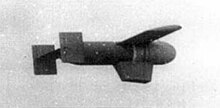GB-4
| GB-4 (Glide Bomb No.4) | |
|---|---|
 | |
| Type | Guided Bomb |
| Place of origin | United States |
| Service history | |
| In service | Combat Tested[1][2][3] |
| Wars | World War II |
| Production history | |
| Produced | 1944 |
| No. built | 1,200 |
| Specifications | |
| Mass | 2,535 lb (1,150 kg) |
| Length | 12.2 ft (3.7 m) |
| Diameter | 24 in (61 cm) |
| Warhead weight | 2,000 lb (910 kg) |
Detonation mechanism | T62 Impact Fuze |
| Engine | none |
Operational range | 17 mi (27 km) Preferred |
| Maximum speed | 250–300 mph (400–480 km/h) |
Guidance system | Block III (AN/AXT-2) television equipment and remote radio control[1] |
GB-4 (Glide Bomb No.4) was a precision guided munition developed by the United States during World War II.[1] GB-4s used a television guidance system with the weapon being steered by a TV bombardier operating a joystick in the launch aircraft.[3]
The first GB-4s (then known as MX-607s) were tested at Eglin Air Force Base during August 1943.[2] During testing the GB-4's circular error probable accuracy was found to be 200 feet (61 m).[1][4] The type was ordered into production on 15 January 1944. Although approved for operational use, the typed suffered from reliability problems throughout testing.[2]
The GB-4 was briefly used in combat[1][3] by the 388th Bomber Group,[2] based in eastern England, but its performance was deemed unsatisfactory.[3] 1,200 GB-4's were delivered to the USAAF however poor combat results lead to a decision to halt further deliveries in February 1945.[2]
See also
[edit]References
[edit]- ^ a b c d e Guidance and Homing of Missiles and Pilotless Aircraft (Report). AAF (US) Scientific Advisory Group, Wright Field. 1946. p. 5. Archived from the original on 5 February 2022.
- ^ a b c d e f Zaloga, Steven J (2020). American Guided Missiles of World War II. Osprey. pp. 40–45. ISBN 9781472839275.
- ^ a b c d Rosenberg, Max (1964). The Airforce and the National Guided Missile Program 1944-1950 (Report). USAF Historical Liaison Office. p. 11.
- ^ OP 1664, US Explosive Ordnance, Volume 2 (Report). Naval Sea Systems Command (NAVSEA). 1947. p. 559.
